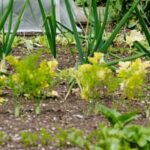Introduction
Kentucky is a great place to grow vegetables. The climate of the state provides suitable temperature and humidity to allow the growth of many different types of crops. The soils of Kentucky can vary significantly from one region to another, but generally they are fertile and well-drained, making them great for growing vegetables. In addition, long autumns with plenty of sunshine make growing fall vegetables especially rewarding in Kentucky. With these aspects in mind, let’s take a look at how to best prepare and plant your fall vegetable garden in Kentucky.
Getting Started
The best time of year to start a Fall Vegetable Garden in Kentucky is late summer, preferably August. Before planting, it is important to draw out a map of where you want your garden to go and make sure the soil is fertile. Resources you will need includes suitable gardening tools such as hoes, trowels and rakes; quality soil; water; natural fertilizers like compost; and vegetable seeds or seedlings. Additionally, the location should get at least six hours of direct sunlight per day and have access to water. It is also important to rotate crops every season so insects and pathogens do not accumulate on the same plants yearly.
Choosing the Right Vegetables
The best vegetables for a fall vegetable garden in Kentucky include: Broccoli, Brussel Sprouts, Swiss Chard, Collards, Peas, Kale, Lettuce, Mustard Greens, Radishes, Spinach and Turnips. In particular it is recommended to choose varieties that are bred or adapted specifically for the Southern U.S., as these will have better growth in warmer climates than those geared towards colder climates closer to the northern Canada border. Additionally it is important to consider vegetables that have shorter harvest times that can be grown during the warmer months of a Kentucky fall. As such quick maturing crops like peppers, spinach and radishes are great choices for a fall vegetable garden in Kentucky.
Preparing the Soil and Planing Your Beds
When starting a fall vegetable garden in Kentucky, it is important to first consider what you will be planting and when. Knowing your expected date of the last frost will influence the types of vegetables that can be planted efficiently. The best vegetables for the area include green beans, kale, squash, spinach, carrots and potatoes.
Once you have chosen your vegetables, proper soil preparation is key to getting off to a strong start. Incorporating aged compost or manure can help improve the quality of your soil and gives it more nutrients which plants need to grow healthily. When planning your beds, create rows in sections with enough space between them for easy access. Be sure to leave plenty of space between each row so that plants have adequate root systems and easily attain sunlight throughout their growth cycle. Planting wisely in succession succession will help ensure there is always something ready for harvest at any given time in the season.
Once your garden plot is established use crop rotation practices between plantings by moving plants from one section of soil to another from season to season. This helps balance out nutrient depletion and reduces chances of disease or pest issues as well as improves soil fertility which encourages healthy plant growth overall. Finally, if starting from seed be sure read instructions carefully and supplementing with essential nutrients throughout the course of the growing season as needed for best results.
Caring for Your Garden
Watering: To ensure the best productivity from your fall vegetable garden in Kentucky, you should aim to provide adequate water. Depending on the rainfall and soil conditions in your region, you may need to supplement with irrigating systems. As a general rule of thumb, vegetable gardens usually require 1-2 inches of water every week in order to maximize yields. Always check your soil before watering, and avoid overwatering as this can lead to root rot or other issues.
Fertilization: To keep your fall vegetable garden productive throughout the harvest season, regular fertilization is essential. A good quality fertilizer designed for vegetable gardens is recommended; one that is high in nitrogen will help promote lush green growth, while one containing both nitrogen and phosphorous will encourage fruiting and flowering. Fertilize regularly but use small amounts at a time; too much fertilization can lead to certain elements becoming unavailable or toxic levels being reached within the soil.
Pest Control: To maintain a healthy fall vegetable garden in Kentucky, you should be vigilant against potential pest infestations. Early detection is always best when it comes to controlling unwelcome visitors such as aphids or slugs; timely removal of affected vegetation or plants may prevent widespread damage later on down the line. Natural methods such as dipping small sheers into soapy water are often preferred over harsh chemicals due to their minimal environmental impact – always do research before using any kind of pesticide!
Harvesting and Storage
The best way to pick vegetables from a fall vegetable garden in Kentucky is to take them when ripe. Under-ripe vegetables will not last as long as fully- ripened ones and may jeopardize the success of other vegetables in your garden. It’s also important to handle vegetables with care while picking, as damage can lead to produce spoiling earlier than expected. To keep vegetables fresh for the longest amount of time, it is beneficial to store them in a container or refrigerator before using them. Refrigerating helps to reduce spoilage by slowing the rate of oxygen and water exchange, thus preserving them for longer periods of time. When storing produce long term, it is best to use methods like canning, freezing, drying or pickling. These methods of preservation help ensure that your food won’t go bad quickly and that the nutritional value will remain consistent throughout the process.
Conclusion
Growing a Fall Vegetable Garden in the state of Kentucky has a wide range of potential benefits. The most notable is that homegrown vegetables are an excellent source of nutrition, which can lead to better overall health. Eating locally-grown, fresh produce is much healthier than relying on store-bought items which can potentially be lacking essential vitamins and minerals. Additionally, growing your own food provides peace of mind when it comes to quality and consistency. It also allows you to exercise greater control over the level of pesticides and other potentially harmful chemicals used in the process.
In addition to its nutritional benefits, growing a Fall Vegetable Garden in Kentucky can also benefit the local environment. Growing your own fruits and vegetables requires fewer resources such as energy, water and land, thus reducing pollution associated with their production. Furthermore, this helps preserve natural habitats for native wildlife that might otherwise be impacted by large-scale commercial agriculture operations. Finally, developing vegetable gardens increases biodiversity within an urban or suburban area by introducing multiple types of plants that may have different pollination cycles or insect profiles which provide important ecosystem services for both humans and wildlife alike.

If you’re looking to get into vegetable gardening, or are just looking for some tips on how to make your current garden better, then you’ve come to the right place! My name is Ethel and I have been gardening for years. In this blog, I’m going to share with you some of my best tips on how to create a successful vegetable garden.





